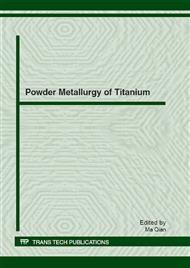p.242
p.248
p.254
p.261
p.269
p.276
p.281
p.289
p.295
Microstructure and Mechanical Properties of Ti-ZrO2 Composites Fabricated by Spark Plasma Sintering
Abstract:
This study aims to investigate the microstructure and mechanical properties of Ti-ZrO2 composites and ZrO2/Ti functionally graded materials (FGMs) fabricated by spark plasma sintering (SPS). SPS has been conducted in a vacuum at 1400 oC under the uniaxial pressure of 30 MPa. Mechanical properties such as hardness and elastic modulus of Ti-ZrO2 composites have been systematically investigated using micro-Vickers and nanoindentation. The experimental results demonstrate that the mechanical properties of Ti are dramatically improved by an addition of small amount of ZrO2. There is almost no effect from the presence of Y2O3 in ZrO2 on the hardness of Ti-ZrO2 composites. ZrO2/Ti FGMs have been successfully fabricated, and mechanical properties of the FGMs have been examined.
Info:
Periodical:
Pages:
269-275
Citation:
Online since:
August 2012
Price:
Сopyright:
© 2012 Trans Tech Publications Ltd. All Rights Reserved
Share:
Citation:


